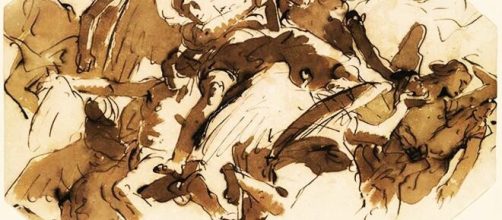Natural ability may be another way of saying an inherited ability. Genetics certainly plays a part in art history.
Prompting this thought is the new show of drawings by Giambattista Tiepolo and his son Domenico at the Morgan Library and Museum in New York, holder of one of the largest collections of Tiepolo drawings in the world.
Most of the drawings were made in preparation for frescoes on palace ceilings and walls. The exhibit, called “Spirit and Inventions,” plays up the theatrical flair of father and son; although as far as the Morgan Library is concerned, the “magnum opus” is the father’s ceiling fresco above the staircase at the Würzburg Residence.
But wait, Tiepolo’s son Domenico worked with his father on the painting above the stairwell known as “Apollo and the Four Continents.” So, you’re left wondering who did what. At least Domenico got some credit of his more secular works that include sketches of the traditional puppet show "Punch and Judy."
Who dunnit?
Alas, that nagging who-did-what question takes on extra importance, as you will see in a moment.
Given the father-son aspect of this show, thoughts went to other art families like the Brugels – Pieter the Elder, known for his genre paintings, and his son Pieter the Younger, who was given to fantasy imagery. Or was it his brother Jan the Elder? See what I mean? The only sure thing is the work of the father, Pieter the Elder.
There’s another point to be made here. While talent looks to be genetic, it’s notable that gender has nothing to do with it. You can see this in literature. In 2014, The New Yorker ran a memorable story “What Makes a Family of Artists” and referred to the writing of the Brontes – Charlotte and Anne.
Daughters of a different revolution
As well, in 2018, art historian Karen Chernick compiled a list for Artsy of painting families with the usual suspects on the list. But she did something else rarely noted. She named father-daughter artist teams.
And that’s when who-did-what question intensifies. The Renaissance boasts several father-daughter examples. While it was the custom for master painters in that time to take on their sons as apprentices, a few worked with their daughters, whose only other career choices were nunnery or marriage.
Paolo Uccello’s daughter Antonia Doni chose to join the Carmelie order, but she also applied the art lessons on perspective that she learned from her father to assist him on his commissions. And it’s impossible to know what part of his work is hers.
The who dunnit question also arises in the work of Jacopo Tintoretto and his daughter Marietta Robusti. She was her father's apprentice in his studio, and not in a minor role.
In a 1642 biography “The Life of Tintoretto” by Carlo Ridolfi referred to Marietta as “the dearest delight of Tintoretto’s,” adding that “men were amazed by her lively talent.” And because her style was like her father’s, all their works are credited to him.
Given the accolades for Marietta’s talent, one may wonder why the work she did independent of her father is not known the way Dominio Tiepolo’s is.
Anyway, these are some of the women in the Renaissance who worked in their fathers’ studios that we know about. Makes you wonder how many famous painters’ daughters got left out of their picture.
I can’t help thinking of that 2018 movie “The Wife.” Did you see it? It’s streaming on Netflix. Glen Close plays the spouse who re-writes her husband’s badly-written stories to earn him a Pulitzer Prize. Not the same as the genetic story, but the who dunnit question is.


